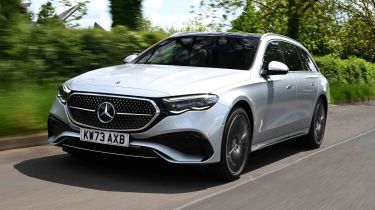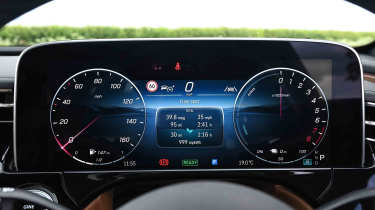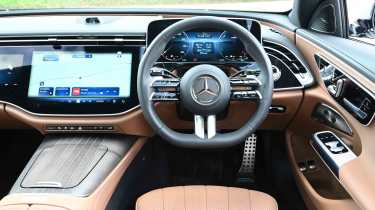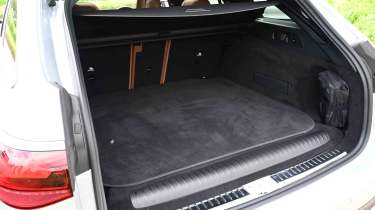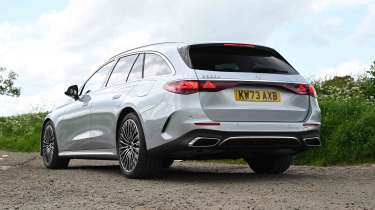Mercedes E-Class Estate review
The latest E-Class Estate is big on comfort and tech, but it’s no longer a leader in the space race

Is the Mercedes E-Class Estate a good car?
The Mercedes E-Class Estate is a technological tour de force, plus it remains one of the most desirable load luggers money can buy. It also offers exceptional comfort and refinement, and a comprehensive line-up of powertrains. The plug-in hybrid units are especially impressive, delivering a strong blend of performance and efficiency - although this does come at the cost of practicality, which is a shame given this car’s otherwise spacious estate body. The only other disappointment is the handling, which is composed and capable but lacks the driver appeal of some rivals.
|
Key specs | |
|
Fuel type |
Petrol, diesel, plug-in hybrid |
|
Body style |
Estate |
|
Powertrain |
2.0-litre, 4cyl, turbocharged, petrol, rear-wheel drive, automatic |
|
Safety |
5-star Euro NCAP (2024) |
|
Warranty |
3yrs unlimited mileage |
How much does the Mercedes E-Class Estate cost?
The Mercedes E-Class is the flagship of the German brand’s estate car line-up, sitting above the CLA Shooting Brake and C-Class Estate. There’s been a big estate of some sort in the firm’s line-up since 1965, but the first to wear an E-Class badge was the facelifted S124 in 1993. The current sixth-generation model was revealed in 2024 and uses Mercedes’ versatile MRA2 architecture that also underpins the smaller C-Class and larger S-Class models.
As you’d expect, given its status within the Mercedes range, the E-Class isn’t a cheap option. Prices start at a fraction under £58,000 for the E 200 in AMG Line trim, while the similarly specified E 220 d is just under £1,500 more. These are the only two engine options for this trim.
Used - available now

2020 Mercedes
E Class
35,726 milesAutomaticDiesel2.0L
Cash £26,187
2020 Mercedes
E Class
16,426 milesAutomaticDiesel2.0L
Cash £30,587
2020 Mercedes
E Class
15,166 milesAutomaticPetrol2.0L
Cash £23,906
2022 Mercedes
E Class
44,201 milesAutomaticPetrol2.0L
Cash £25,300Stepping up to the AMG Line Premium will cost you around another £5,000, plus opens the door to the plug-in hybrid E 300 e and E 300 de, which will set you back around £72,000 and £74,000 respectively, while the powerful E 450 d 4Matic is a whisker under £80,000. The extra outlay also buys you extras such as adaptive LED headlamps, a panoramic glass roof, keyless access and a powerful Burmester sound system.
Add another £7,000, and you’ll be handed the keys to an AMG Line Premium Plus car, which is available with the same range of engine options. It costs a lot extra, but it does bring the full-width Superscreen dashboard, 20-inch alloys, massaging front seats and - if you like that sort of thing - an illuminated radiator grille.
Sitting alongside these trims are the Exclusive Premium and Exclusive Premium Plus models, which are priced the same as the AMG Line Premium and AMG Line Premium Plus trims, respectively. The two Exclusive trims feature much the same equipment as the AMG Line equivalents, but ditch the racy AMG add-ons in favour of a more traditional look.
Sitting somewhere in the middle of these models is the Urban, which is a trim aimed at business users and only available with the plug-in hybrid powertrains. It gets some of the sporty AMG features, such as 20-inch alloys and gloss black exterior elements that aim to give it a bit of company car park kudos. Prices start at just under £63,000, rising to £65,000 for the diesel.
Sitting at the top of the range is the Mercedes-AMG E 53 flagship, which starts at a hefty £91,000 or thereabouts. It’s comprehensively equipped as standard, but for another £6,000 you can have the Night Edition Premium Plus edition that adds features such as a head-up display, four-zone climate control and heated armrests.
For a further £19,000 you can upgrade to the Edition 1 model complete with 21-inch alloys, Superscreen dash and the AMG Dynamic Plus pack that adds extra driver modes, active engine mounts, and an electronic limited-slip differential. As a final flourish, the seat belts and stitching for the seats, door trims and steering wheel are all finished in yellow.
Engines, performance & drive
Like the four-door Mercedes E-Class saloon, this estate is available with a wide range of engines. Not only are there fairly traditional petrol and diesel options, there are also plug-in hybrid versions of both. Plus there are high-performance Mercedes-AMG models that aim to combine series pace with lots of interior space.
Kicking off the range is the E 200 petrol, which, despite its engine’s modest size, delivers a decent turn of speed. It’s a mild-hybrid, four-cylinder motor with 201bhp and a healthy 320Nm of torque helping it surge from 0-62mph in 7.8 seconds and onto a top speed of 144mph. Not too shabby for an entry-level model.
Even so, despite diesel becoming a dirty word, the E 220 d is arguably an even better fit for this type of car, its blend of pace and economy proving difficult to beat. The 2.0-litre unit is surprisingly refined, and while it has less power than the petrol (194bhp) it delivers a thumping 440Nm of torque. Its 0-62mph time of 7.9 seconds is a tenth slower, but plenty of mid-range muscle makes it a quicker car in everyday use.
Next up is the E 300 e, which is a plug-in hybrid that essentially mates the E 200’s petrol engine to an electric motor to boost total power to 309bhp. The set-up is well integrated to deliver smooth and seamless acceleration. Perhaps more impressively, this dual-fuel load lugger combines a rapid 6.5-second 0-62mph time with 70 miles of range on electric power alone.
You get the same EV range with the E 300 de, which features the same electrical hardware bolted to the E 220 d’s diesel motor. It’s not quite as refined as the petrol plug-in, but it’s only a tenth of a second slower to 62mph. However, thanks to both getting the instant boost of an electric motor, the E 300 de 2.0-litre’s extra torque isn’t really obvious on the road. It’s not quite as refined and the petrol model, either, although its better efficiency means it’ll run even further between stops at the pumps.
For those who like to talk softly but carry a big stick, the E 450 d is a great choice. Its smooth six-cylinder diesel engine features mild-hybrid technology to deliver 362bhp and 750Nm of torque. It also features the brand’s grippy 4Matic all-wheel drive system that helps put all that power on the road. As a result, the E 450 d can blast from 0-62mph in just 5.0 seconds, which is quick enough to frighten proper sports cars.
At the top of the range is the Mercedes-AMG E 53 Hybrid 4Matic+. Tuned by the brand’s AMG performance division, it combines a six-cylinder 3.0-litre petrol with plug-in hybrid electricals for a combined output of 577bhp and 750Nm of torque. Those figures are a match for the old 4.0-litre V8-powered E 63 model, as is the blistering 0-62mph time of 3.9 seconds. Yet while the six-pot petrol has a nice snarl when worked hard, it lacks the old car’s bellowing soundtrack and hot rod character.
All versions of the E-Class Estate use a nine-speed automatic gearbox, although the AMG model has been tuned differently to offer even sharper responses. Either way, in the best Mercedes tradition it’s a smooth and unobtrusive transmission, slurring gears smoothly enough that you’ll barely be aware they’re happening.
The Mercedes E-Class Estate is a large car, so it will never be as relaxing to drive as a smaller city car through narrow streets. However, it’s incredibly quiet at low speeds, especially in hybrid models that can drive using near-silent electric power without waking the engine.
The suspension is fantastic at masking bumps and potholes, plus the automatic gearbox is smooth in traffic, and the light controls make it a doddle to drive. So as long as you don’t need to park in a tight car park, the E-Class is excellent around town - although its numerous parking aids should mean you’re spared any bumper-grazing blushes.
For keen drivers, the E-Class ranks below the agile and alert BMW 5 Series for fun on twisting back roads. The Mercedes handles accurately and serves up strong grip, but the steering is short of feedback, and the car feels big and heavy compared to its German rivals. There’s also more body roll in tight corners, although things improve once on an open A-road.
On the plus side, the E-Class’s supple suspension smoothes out bumps very well (even in models with large alloy wheels). It does a fantastic job of providing a comfortable feel without jostling you and your passengers when travelling along a bumpy road.
As a result, the E-Class excels on the motorway. Its smooth suspension and powerful engines make it effortless to spend time here, while the low-drag bodywork keeps wind noise low and economy high. The diesel engine in the E 220 d is a little noisy under hard acceleration, but overall refinement is superb, and you could hardly hear the engine in the E 300 e model we tested.
|
Model |
Power |
0-62mph |
Top speed |
|
Mercedes E 200 |
201bhp |
7.8 secs |
144mph |
|
Mercedes-AMG E 53 |
577bhp |
3.9 secs |
155mph |
|
Mercedes E 220 d |
195bhp |
7.9 secs |
143mph |
MPG, emissions & running costs
On paper, the plug-in hybrid E 300 e and E 300 de are the most economical E-Class Estate models - although you’ll struggle to get near the claimed WLTP fuel economy figures in the real world unless most of your driving is within the EV range and you charge frequently. Even then, achieving the E 300 de model’s promised 565mpg will be virtually impossible.
Of the traditionally powered models, the diesel-powered E 220 d comes out on top thanks to its impressive claimed fuel economy of up to 56.5mpg. The entry-level E 200 petrol provides a respectable 41.5mpg at the pumps, which, factoring in the lower cost of unleaded petrol compared with diesel, makes it a tempting choice for drivers who cover less than 12,000 miles a year.
|
Model |
MPG |
CO2 |
Insurance group |
|
Mercedes e 300 de |
565.0mpg |
13g/km |
50 |
|
Mercedes-AMG E 53 |
301.1-30.7mpg |
21g/km |
50 |
|
Mercedes E 220 d |
52.3-56.5mpg |
130-138g/km |
44 |
The most powerful model without full-hybrid assistance is the E 450 d, which returns up to 44.8mpg according to WLTP figures. In terms of its blend of performance and economy, the 362bhp diesel is an impressive option. Better still, use a gentle right foot on long motorway runs, and you’ll likely see even higher fuel returns.
As you’d expect, the rapid Mercedes-AMG E 53 is the thirstiest member of the E-Class Estate family. Despite the plug-in hybrid powertrain’s ability to travel a decent distance in EV mode, Mercedes claims the system is as much about explosive acceleration as it is efficiency. As a result, its claimed fuel figures have been recorded with the battery discharged, resulting in a lowly 30.7mpg.
One of the benefits of the Mercedes E-Class Estate plug-in models is their impressive electric driving range, which is primarily down to a large 25.4kWh battery. For the petrol and diesel E 300 e and E 300 de, this results in a claimed EV range of up to 68 miles, while the flagship E 53 with the same battery promises a 61-mile range. Either way, you can expect a comfortable 50 miles in all-electric mode, even in colder and wetter weather.
The battery can be charged at a maximum rate of 55kW (60kW for the AMG E 53), which allows a 10-80 per cent top-up from a public charger capable of delivering such speeds in around 20 minutes. Most will prefer to charge at home using a cheaper overnight tariff, though.
If you use a typical 7.4kW wallbox charger, Mercedes quotes a 10-100 per cent charge will take three hours. Most other manufacturers quote a 0-100 per cent charge time, so we anticipate it’ll take around four hours to fully replenish a flat battery.
The two diesel engines produce CO2 emissions ranging from 130g/km to 171g/km, while the petrol E 200 sits between the two with a figure of as little as 154g/km, depending on the model. As a result, these versions will incur a far higher Benefit-in-Kind (BiK) company car tax bill than the equivalent E 300 e or E 300 de plug-in hybrid models, which are rated at just eight per cent.
Every E-Class Estate model retails for way over £40,000 when new, which means private buyers will face an annual £415 surcharge on their VED bill for the first five years of ownership. The plug-in hybrid models are eligible for a discount on this extra outlay, but the £10 yearly saving for being an alternative-fuel vehicle is hardly worth writing home about.
No Mercedes E-Class Estate will be cheap to insure, with the entry-level E200 and E 220 d versions falling between groups 41 and 44, depending on the trim. The rest of the line-up are in the top group 50 banding, a reflection of these models’ performance and value, plus the expensive complexity of any potential repairs.
According to our expert data, the Mercedes E-Class should hold its value as well as its arch-rival, the BMW 5 Series Touring, maintaining between 41 and 49 per cent of its original value after three years and 36,000 miles. As ever, the entry-level versions represent the most solid investments, with the E 200 shedding the least value. Experiencing the biggest drop in value is the Mercedes-AMG E 53.
To get an accurate valuation for a specific model, check out our valuation tool...
|
Model |
Battery size |
Range |
Insurance group |
|
Mercedes E 300 e |
25.4kWh |
68 miles |
50 |
|
Mercedes E 300 de |
25.4kWh |
68 miles |
50 |
|
Mercedes-AMG E 53 |
25.4kWh |
61 miles |
50 |
Design, interior & technology
The Mercedes E-Class Estate features exactly the same interior as the saloon, which takes its cues from other Mercedes models. There’s loads of cutting-edge tech on display, and it’s packaged into an interior that aims to combine modern design with an air of traditional luxury.
All models have a 12.3-inch digital driver’s instrument cluster and a 14.4-inch central touchscreen. The example in our pictures has the optional MBUX Superscreen that covers the entire dash, providing the passenger with an additional 12.3-inch display to access apps or watch a movie. It means that where there were once high-quality upholstery and easy-to-use buttons, there’s now just a huge screen.
Between the driver and passenger is a wide centre console that helps to create a nicely cocooning feel, while the sweeping dashboard design is more closely related to the EQE electric model’s than what you’ll find in the traditional C-Class and S-Class saloons.
The Mercedes E-Class Estate features excellent seats that are very comfortable and supportive, with all models getting four-way electric lumbar adjustment. You will have to upgrade to the AMG Line Premium model to gain a memory function on the front seats, but while the powered adjustment makes it easier to find the perfect seating position, it doesn’t affect the overall comfort of the seats.
All the basic equipment you could need is included as standard, including climate control, smartphone connectivity, keyless go, sat-nav with live traffic info, and artificial leather upholstery called Artico. A natural leather alternative is available, while plusher Nappa leather is reserved for Exclusive Premium Plus models.
The slickly designed Mercedes interior certainly looks the part, with the use of gloss black trim and natural wood finishes adding serious premium appeal. At night, the cabin is bathed in comprehensive ambient lighting, which on AMG Line Premium Plus and Exclusive models can be programmed to automatically change depending on the driver mode selected.
However, as in other Mercedes models, the quality of the fit and finish isn’t quite up to the brand’s historically high standards. Poke and prod various areas of the cabin and you’ll find bits of trim flexing, and the odd creak and rattle.
Sat-nav, stereo and infotainment
Like the all-electric EQE and EQS models, the E-Class estate is available with a full-width digital dashboard. Called the Superscreen, it costs around £1,500 and combines a central infotainment screen of 14.4 inches between a pair of 12.3-inch displays – one for the driver and another for the passenger. What Mercedes calls a ‘visual shield’ helps block the passenger display from being seen by the driver, helping to reduce distraction on the move.
As you’d expect, it’s packed with features, with front-seat passengers able to use their own screen to independently access music and apps. The set-up even contains a camera on top of the dashboard for video conferencing and selfies.
Despite its complexity, the set-up is surprisingly easy to use thanks to Mercedes’ Zero Layer concept, which allows you to access the most frequently used functions without having to delve through multiple sub-menus. Either way, like it or loathe it, there’s no denying this eye-catching set-up will be a conversation starter for first-time passengers.
Standard versions of the E-Class Estate go without the passenger-side display, but do get the 14.4-inch infotainment and 12.3-inch instrument cluster ahead of the driver. Smartphone connectivity is also included in all versions of the E-Class, so you’ve got Apple CarPlay and Android Auto as standard, even without the Superscreen option.
Boot space, comfort & practicality
|
Dimensions | |
|
Length |
4,950mm |
|
Width |
1,880mm |
|
Height |
1,470mm |
|
Number of seats |
5 |
|
Boot space |
615-1,830-litres (460-1,675-litres, PHEV) |
At a whisker under five metres long and nearly two metres wide, the Mercedes E-Class Estate is a big car, even for a full-sized family wagon. The upshot of this is that it offers plenty of space inside for people and their luggage. Moreover, it fits in virtually the same-sized footprint as the BMW 5 Series Touring, proving that this class of car continues to get larger and larger.
Up front, the front seats are comfortable and supportive, and finding the perfect driving position is child’s play thanks to the wide range of seating adjustments. Entry-level Urban models feature heated seats, while all other models benefit from heating and cooling. The high centre console helps give a cosy feel, but there's still plenty of space thanks to the car’s overall width. In fact, when tackling a long trip, few places are as welcoming as the front seats of an E-Class.
Those in the rear will have little to complain about either. Three adults can comfortably be seated on the rear bench, although the middle passenger will have to straddle a large central tunnel and contend with a slightly raised seating position, so they won’t want to be there for more than short trips.
Occupants of the outer seats fare better, with more legroom than in a BMW 5 Series. Headroom is good too, the estate’s extended roofline making it less cramped than the sleeker saloon equivalent. These seats can also be used for accommodating child seats, with the easily accessible Isofix mounting points hidden behind some rubber covers.
You’re not short of handy storage either, with that large centre console housing a cubby and a pair of cup-holders beneath a sliding panel, plus a deep compartment underneath the centre armrest. A large glovebox provides further space for odds and ends, as do the large door bins front and rear. Rear-seat passengers also get a fold-down centre armrest that contains another two cup-holders.
As you’d expect from a Mercedes estate, the E-Class boasts a decent amount of luggage space - although those wanting to maximise carrying capacity should steer clear of the plug-in hybrid models. The need to house the battery beneath the boot floor means there’s only 460 litres of space with the seats up; to put that in perspective, a Vauxhall Astra hatchback can carry up to 422 litres. However, folding the Merc’s rear bench flat extends the available space to 1,675-litres.
There’s better news in the E 200, E 220 d and E 450 d, which offer 615 litres of space with all the seats up, growing to 1,830 litres when folded. Regardless of powertrain, the E-Class Estate features a handy 40:20:40 split-fold rear seat, a wide boot opening with a low load lip, and a powered tailgate.
Whichever engine you choose, the Mercedes E-Class Estate will be a handy towcar, thanks to a maximum braked trailer limit of 2,100kg. Mercedes offers an optional folding towbar for around £700, which also comes with a special setting for the electronic stability programme that takes account of any trailer or caravan movements for safer and more stable behaviour in emergency situations.
Safety & reliability
Mercedes has a long and enviable reputation for safety, introducing the car-buying public to crumple zones and airbags. Today, it leads the way with advanced driver aids, so it’s no surprise to find the E-Class Estate score so strongly in Euro NCAP testing.
When the safety specialist assessed the technically identical E-Class saloon in 2024, it handed it a five-star rating for safety. It scored 92 per cent in the Adult Occupant category and 90 per cent for children, plus an impressive 87 per cent score for safety tech.
The standard kit includes adaptive high beams, traffic-sign assist, adaptive cruise control, parking assist, pedestrian protection and a reversing camera. Spend an extra £1,700, and you can add the Driving Assistance Package Plus, which adds stop and go functionality to the adaptive cruise control, as well as active assistance with lane keeping and steering inputs during emergency manoeuvres. Another neat feature is the ability to use the sat-nav to automatically slow the car for corners, roundabouts, junctions or other fixed road hazards if the car senses the driver hasn’t adjusted their speed appropriately.
The latest Mercedes E-Class is too new to have made an appearance in our most recent 2024 Driver Power customer satisfaction survey, but its predecessor finished a disappointing 27th overall. The German firm overall ended a disappointing 25th out of 32 brands in the separate manufacturers poll. Owners like their cars, but Mercedes’ customer service and after sales pricing could be a lot better.
Mercedes provides a three-year warranty on all its cars, which is on par with the industry standard and its main rivals. If you want a longer warranty, it’s best to choose a car from a manufacturer like Kia or Toyota, because these companies offer more than the basic three years of cover. At least the Mercedes warranty matches the BMW policy by offering unlimited mileage.
|
Key standard safety features |
Euro NCAP safety ratings |
|
|
Mercedes E-Class Estate alternatives
The market for large and luxurious estate cars has been particularly hard hit by the massive growth in upmarket SUV sales. As a result, the Mercedes E-Class Estate has a rather small pool of rivals, especially now the Jaguar XF Sportbrake is no longer available new.
Arguably the E-Class’s toughest rival is the BMW 5 Series Touring, which has a fractionally smaller boot but delivers a more engaging driving experience without sacrificing comfort and refinement. There’s no longer an entry-level diesel option, but the BMW is available with mild-hybrid and plug-in powertrains, while the BMW i5 Touring offers a fully electrified option.
Another stalwart of the luxury load-lugger class is the Volvo V90, which has returned to the UK after the brand briefly halted sales of all estate cars here. Like the E-Class, it’s a car tuned for comfort rather than fun, but it’s a relaxing and spacious choice, while the plug-in hybrid editions offer a decent blend of performance and efficiency.
Finally, while Audi has pulled the plug on the A6 Avant, an all-new Audi A6 Avant e-tron will arrive in Britain early in 2025. As its name suggests, this will be an all-electric model, with a range of up to 437 miles on top-spec versions. However, there are currently no plans for traditional petrol, diesel or hybrid powertrains in this sleek-looking newcomer.
Frequently Asked Questions
Mercedes offers a standard three-year warranty on its cars, although unlike many, there is no mileage limit. Roadside recovery is also included, which the brand will continue to provide free of charge for up to 30 years if the car is serviced annually at an authorised dealer.
More reviews
Car group tests
In-depth reviews
Road tests
Used car tests
Which Is Best
Fastest
- NameE450d 4M AMG Line Premium 5dr 9G-Tronic [Pan Roof]
- Gearbox typeSemi-auto
- RRP£83,245
